By Eilene Lyon
August 28, 2018
Drove back past the nearly empty reservoir at Paonia State Park. Mostly there’s just a muddy meander through the accumulated silt. A few feet of water stand at the south end nearest the dam. Cattle were grazing on the now-exposed terraced sides. As our mountains and rivers out west dry up, I expect many dams and reservoirs will become anachronisms.
August 31, 2018
The Blue Mesa Reservoir was even more stunningly void of water than Paonia’s. The basin is looking like a verdant pasture that will soon revert to its former sandy, desert-canyon self. There is a stark horizontal line between the high water mark with its row of native trees and shrubs, and the tiers of the basin, like the ridges on a clam shell. The dam seems perfectly pointless. A few houseboats cruised the lower end of the vanishing puddle. Row-crops of RVs hovered around the edges to watch the evaporation of the reason for recreating.
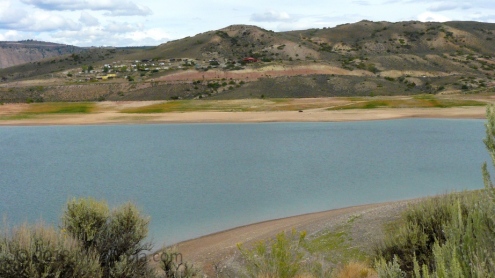
The Colorado River watershed is the seventh largest on the North American continent, draining 246,000 square miles (640,000 km2).1 In the mid-19th century, the river and its tributaries were still largely a mystery to Americans, part of the “Great American Desert,” i.e. everything west of the 100th meridian.
In 1869, Maj. John Wesley Powell led his famous exploration down the Colorado, starting from Green River, Wyoming. That terrifying trip and his other explorations of the west were reported to Congress.

“At the beginning, Powell reconfirmed his view, which he had already submitted to an unbelieving Congress, that two-fifths of the United States has a climate that generally cannot support farming without irrigation…‘When all the waters running in the streams found in this region are conducted on the land,’ Powell said, ‘there will be but a small portion of the country redeemed, varying in the different territories perhaps from one to three percent’ (emphasis added).” – Marc Reisner Cadillac Desert
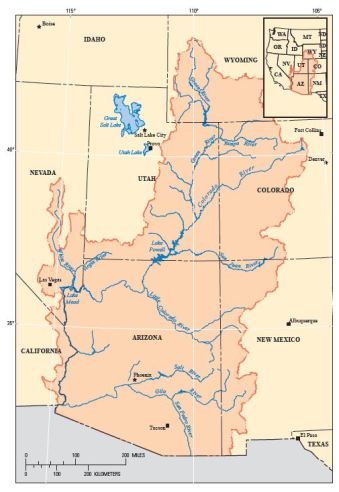
In the 20th century, our government began extraordinary water reclamation efforts in this arid region. On the Colorado, the major impoundments are Lake Powell (Powell rolls over in his grave at the mention of this name-sake abomination) and Lake Mead.
Currently, Lake Powell is at less than 47% of its capacity, having dropped more than 35 feet since last year. Year-to-date inflows are just over 50% of the average for this time of year. Irrigation deliveries for the year barely exceed the minimum requirement.2 Are we seeing a trend?
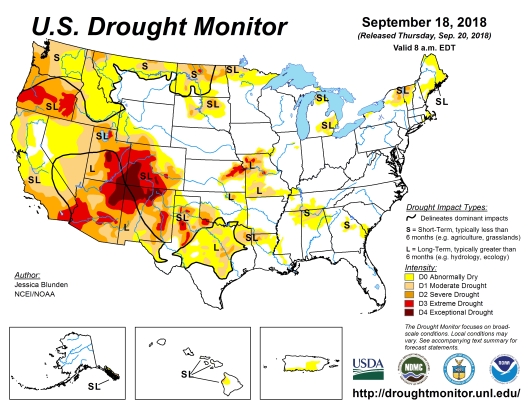
In 2013, the seven states in the Colorado River Compact were irrigating nearly 3% of their land area for agriculture, close to Powell’s estimated maximum.3 This figure does not reflect other irrigation uses (such as golf courses and lawns). Is this sustainable in a drought? And given our changing climate, is the current drought reflecting a “new normal?”
Large reservoirs are not only outrageously expensive, they are an inefficient way to store water. The estimated evaporation rate for Lake Powell and Lake Mead combined is 1.4 trillion cubic meters per year, “and is approximately 5–6 times the annual water usage of a medium-sized city in the United States, such as Denver, Colorado.” 4
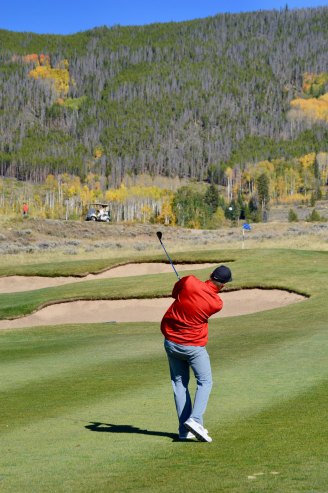
“With huge dams built for him at public expense, and irrigation canals, and the water sold for a quarter of a cent per ton – a price which guaranteed that little of the public’s investment would ever be paid back – the West’s yeoman farmer became the embodiment of the welfare state, though he was the last to recognize it…Released from a need for justification, released from logic itself, the irrigation program Powell had wanted became a monster, redoubling its efforts and increasing its wreckage, both natural and economic, as it lost sight of its goal.” – Marc Reisner Cadillac Desert
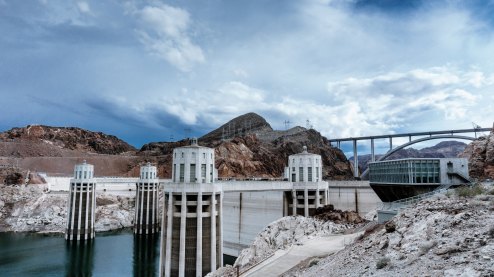
Feature image: Lake Powell’s “bathtub ring,” bleached sandstone, starkly illustrates the dramatic drop in water levels. This was taken in 2002. The ring is much, much larger today. (E. Lyon)
Other posts in this series:
The Drought Diaries: Too Little Water/Too Much Water
- https://en.wikipedia.org/wiki/Colorado_River#Watershed ↩
- http://lakepowell.water-data.com/ ↩
- “Table 1-6. Total farm irrigated acres in the open (and percent distributions), by farm-size class by State, for all 2013 irrigated farms.”USDA Economic Research Service. Summarized data for all irrigated farms. https://www.ers.usda.gov/data-products/irrigated-agriculture-in-the-united-states/ Provides irrigated acreage from which I calculated the percent (2.87%) based on total acreage for the seven Colorado River Compact states.↩
- https://journals.ametsoc.org/doi/full/10.1175/BAMS-D-15-00224.1# ↩
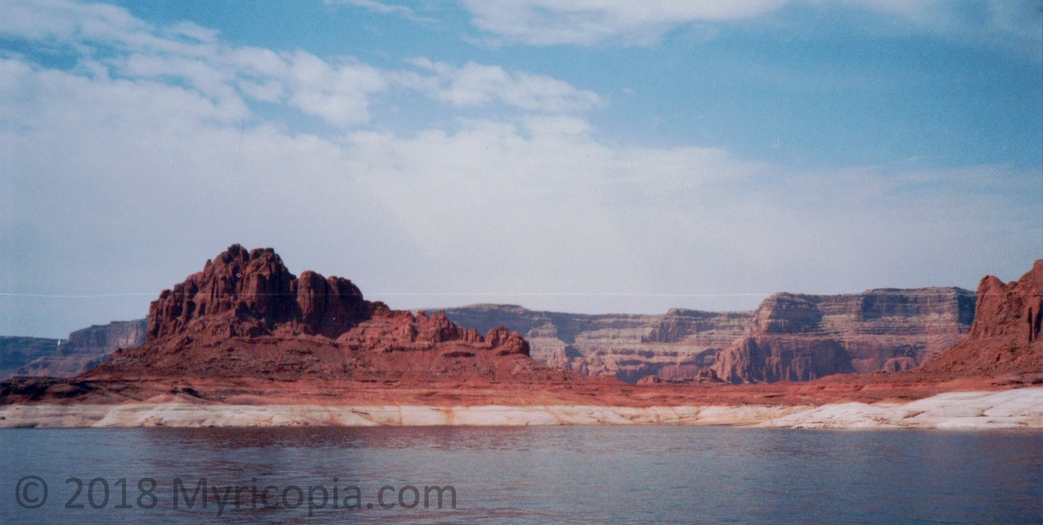
The drought here in California a few years ago certainly got scary. Now they poured all those reflector balls into one of the big reservoirs to help slow the evaporation process, and a lot of places use recycled water for things like watering and car washes. Hopefully we can all put our heads together and come up with solutions for scary stuff like this!
LikeLiked by 1 person
I wonder when we will find the political will to not allow continued development in areas where it is unsustainable. Water is life. We’re depleting our aquifers in the West. It has to stop. At least some people are coming up with creative ideas, but how much do those reflector balls cost? And what are they made of?
LikeLiked by 1 person
It’s true what you say about the politics. At some point we’re going to have to let life win over money! The balls are made of plastic (which has concerns of its own too). Here’s a video of them getting dumped into the lake which I must admit is fun to watch 🙂 https://www.theguardian.com/environment/video/2015/aug/12/96m-water-saving-shade-balls-released-into-los-angeles-reservoir-video
LikeLike
That’s pretty wild! But don’t get me started on plastics!! Or all the times we try to solve our mistakes by compounding them. *sigh*
LikeLiked by 1 person
Never enough feasibility studies. Spend money first. Realize failure second.
LikeLiked by 1 person
LOL. You’ve got that right!
LikeLiked by 1 person
I was at Hoover a couple years ago. Amazingly low! There are boat ramps a mile from the water at abandoned resorts. I think they maybe overbuilt that one. Now they’ve reconstructed auxiliary spillways just so the water can pass the dam. Really remarkable place though.
LikeLiked by 1 person
Some people around here think the Glen Canyon dam should come down – there isn’t enough water for two reservoirs this size. It would reduce the evaporation problem.
LikeLiked by 1 person
So much water is wasted on keeping lawns green. Just think how much water would be conserved if people in North Americas, stopped watering their lawn, replaced them with drought resistant plants and practiced water conservation.
LikeLiked by 1 person
All very good ideas! It’s our food that requires more water than anything. I like reading about better ways to recycle ag water.
LikeLiked by 1 person
Agreed. I don’t know much about recycling ag water. It would be interesting to learn more.
LikeLiked by 1 person
I’ll do some research!
LikeLiked by 1 person
Looking forward to reading about it!
LikeLiked by 1 person
That’s dinosaur bone hunting territory! 🙂
LikeLiked by 1 person
Or uranium!
LikeLike
We visited Lake Powell in 2009 or 10. Sounds as though we would see a big difference now.
LikeLiked by 1 person
I think you would!
LikeLiked by 1 person
Eilene,
Every level of government is complicit in these issues. They justify development to the detriment of our future. They borrow on that future with no intention of ever paying it back. Sad thing.
LikeLiked by 1 person
Americans are so short-term minded.
LikeLiked by 1 person
It’s maddening.
I live in an area where farmland has been razed for strip centers, big box stores and outlets. Not only has Lancaster County lost its identity, it is setting itself up for so many issues down the road.
LikeLiked by 1 person
The capitalist mantra is “economic growth” with no serious consideration that maybe growth isn’t necessarily a good idea, especially on a finite planet.
LikeLiked by 1 person
Yes, the finite quality of resources seems to be lost inside that bigger and badder mentality.
LikeLiked by 1 person
I’ve been to the dam twice and all I can think of is the men who died building it.
LikeLiked by 1 person
Men have been dying on infrastructure projects for millennia, I think. Start with the pyramids, perhaps? Expendable human lives seem to be the one resource that isn’t finite!
LikeLiked by 1 person
Ugh. It seems unbearable by today’s standards.
LikeLiked by 1 person
I hear you.
LikeLiked by 1 person
Somehow seemed wrong to ‘like’ this post given the subject matter, but as usual your writing is impeccable and research is spot-on.
LikeLiked by 1 person
When I compared our watershed map to the current drought map, I had to take a big gulp. It really is a serious subject. Thanks for the compliments!
LikeLiked by 1 person